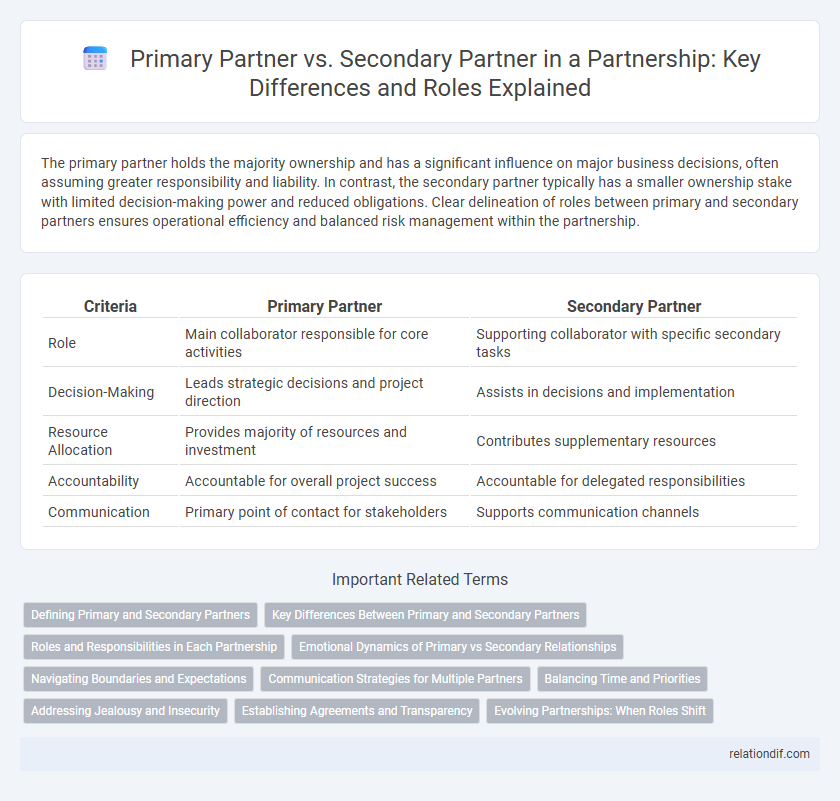The primary partner holds the majority ownership and has a significant influence on major business decisions, often assuming greater responsibility and liability. In contrast, the secondary partner typically has a smaller ownership stake with limited decision-making power and reduced obligations. Clear delineation of roles between primary and secondary partners ensures operational efficiency and balanced risk management within the partnership.
Table of Comparison
| Criteria | Primary Partner | Secondary Partner |
|---|---|---|
| Role | Main collaborator responsible for core activities | Supporting collaborator with specific secondary tasks |
| Decision-Making | Leads strategic decisions and project direction | Assists in decisions and implementation |
| Resource Allocation | Provides majority of resources and investment | Contributes supplementary resources |
| Accountability | Accountable for overall project success | Accountable for delegated responsibilities |
| Communication | Primary point of contact for stakeholders | Supports communication channels |
Defining Primary and Secondary Partners
Primary partners are those with the most significant influence, responsibilities, and stakes within a partnership, often holding decision-making authority and key roles in operations or management. Secondary partners contribute support, resources, or expertise but typically have limited control, lower financial investment, and less involvement in strategic decisions. Clearly defining primary and secondary partners ensures clarity in roles, liability, profit distribution, and governance structure within the partnership agreement.
Key Differences Between Primary and Secondary Partners
Primary partners typically hold majority ownership, leading decision-making roles and bearing the highest financial responsibility in a partnership. Secondary partners often possess minority stakes, contributing support, specialized expertise, or additional resources without control over daily operations. The distinction primarily lies in influence, liability exposure, and profit-sharing ratios between primary and secondary partners.
Roles and Responsibilities in Each Partnership
Primary partners hold the main decision-making authority and manage the overall strategic direction, financial investments, and legal obligations of the partnership. Secondary partners support operational tasks, contribute specific expertise, and share in profit distribution without bearing the same level of liability or control. Clear delineation of roles ensures balanced workload distribution and accountability within both primary and secondary partnerships.
Emotional Dynamics of Primary vs Secondary Relationships
Primary partners often experience deeper emotional intimacy and a stronger sense of commitment due to shared values and long-term goals, fostering a stable and secure attachment. Secondary partners may encounter more fluid emotional boundaries and varying levels of involvement, which can lead to challenges in emotional validation and connection. Understanding these dynamics is crucial for managing expectations and nurturing respectful, balanced relationships within diverse partnership structures.
Navigating Boundaries and Expectations
Primary partners typically hold the central role within a partnership, influencing key decisions and emotional investment, while secondary partners may have more flexible or defined boundaries regarding time and commitment. Clearly communicating expectations and respect for each partner's needs helps navigate potential conflicts and ensures mutual understanding. Establishing these boundaries is crucial for maintaining balance, trust, and satisfaction among all parties involved.
Communication Strategies for Multiple Partners
Effective communication strategies for multiple partners prioritize clarity, consistency, and role definition, ensuring the Primary Partner facilitates centralized information flow while Secondary Partners stay aligned with shared goals. Utilizing tools like collaborative platforms and regular check-ins enhances transparency and mitigates misunderstandings among diverse stakeholders. Establishing clear communication protocols tailored to each partner's involvement level strengthens cooperation and accelerates decision-making processes.
Balancing Time and Priorities
Primary partners allocate the majority of their time and resources to nurturing the relationship, often prioritizing shared goals and consistent communication to maintain balance. Secondary partners typically manage their involvement with greater flexibility, balancing other commitments while ensuring meaningful interaction and support. Effective partnerships depend on clear expectations and mutual respect for different time investments to sustain harmony and growth.
Addressing Jealousy and Insecurity
Primary partners often experience higher emotional investment and time commitment, which can trigger jealousy and insecurity in secondary partners who may feel neglected or less valued. Open communication and clear boundaries between all partners help address these feelings, fostering trust and emotional security. Prioritizing empathy and regularly validating each partner's feelings can reduce misunderstandings and strengthen the overall partnership dynamic.
Establishing Agreements and Transparency
Establishing clear agreements between primary and secondary partners is essential for defining roles, responsibilities, and expectations to ensure operational efficiency. Transparency in communication fosters trust, enabling partners to address conflicts proactively and maintain alignment on shared objectives. Documented agreements and regular updates promote accountability and reinforce a collaborative business relationship.
Evolving Partnerships: When Roles Shift
In evolving partnerships, the distinction between a primary partner and a secondary partner becomes fluid as roles shift to adapt to new business strategies and market demands. Primary partners typically drive core decisions and strategic initiatives, while secondary partners increasingly contribute specialized expertise or support functions. This dynamic restructuring enhances collaboration, fosters innovation, and ensures the partnership remains resilient amid changing operational landscapes.
Primary Partner vs Secondary Partner Infographic

 relationdif.com
relationdif.com